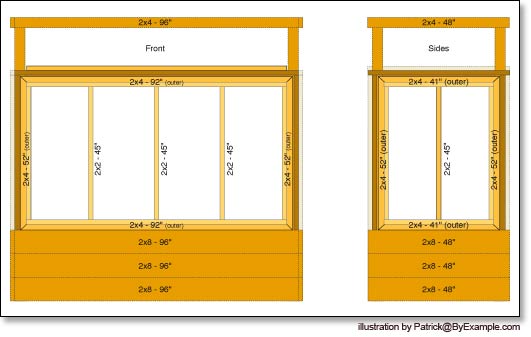Cold Frame Design
It's January and I thought that fresh vegetable season would be long gone by now...but the addition of cold frames to our raised garden beds have kept our winter vegetable garden going. All in all, we are very pleased with our first cold frame design.
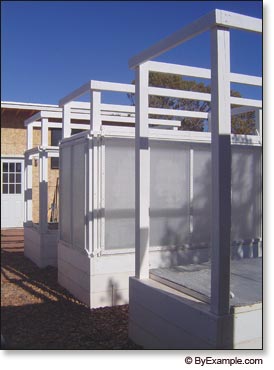
How to Build a Cold Frame
This fall we built a series of experimental cold frames and have been amazed by their performance. The cold frames are designed to work with the raised garden beds we constructed earlier in the year. We plan to build several more cold frames with this method and expand our winter gardening capabilities.
We constructed each cold frame panel according to the measurements on our cold frame plans. We constructed the frames from 2x2s, 2x3s, and 2x4s that we primed and painted before covering with plastic sheeting. There are several layers to each cold frame.
For a single cold frame we secured 6 mil clear plastic sheeting to both the front and back of a wood frame, using a staple gun. In order to protect the plastic glazing we attached a layer of chicken wire on top of the cold frame; it sits about a half inch above the plastic on a second smaller frame. The plastic sheets create a double-paned effect and improve the insulating abilities of the cold frame.
Now that we see how well the 6 mil plastic sheet is working in the cold frames we are making plans to replace it with rigid greenhouse glazing for a longer lasting solution.
Cold Frames in the Garden
This winter we are using the cold frames in 2 configurations to see which works the best. At this point both applications seem to be working pretty well, though each has its advantages and disadvantages.
Tall Cold Frames
The tall cold frame used more materials and took more energy to construct, but it will work for larger plants. Next year I will even try to overwinter Siberian tomatoes in the tall cold frame. When completely assembled the structure the kind of looks like a mini greenhouse.

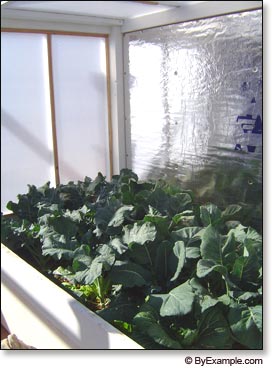
In this configuration, there are 3 clear cold frame side panels and a clear cold frame top panel attached to the raised garden bed frame. In addition, there is a panel for the North side of the garden bed; it is a simple wood frame fitted with a sheet of foil-lined rigid insulation. The foil insulation not only helps to hold the heat, but reflects light down into the bed, enhancing the amount of light available to plants. Each of the cold frames is held into place with a set of wooden latches. The latches can be swiveled to release the cold frames and allow access to all sides of the garden bed.
Economy Cold Frame
This configuration only requires one cold frame. It is placed directly over a raised garden bed. This system is ideal for low growing winter greens and works best when the soil level is a foot or so below the edge of the the raised bed. In our single cold frame beds we are currently growing spinach, Swiss chard, Siberian kale, Kyona mustard, beets, carrots and Chinese cabbage.
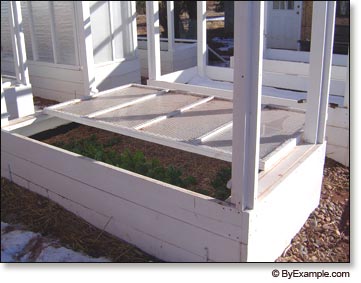
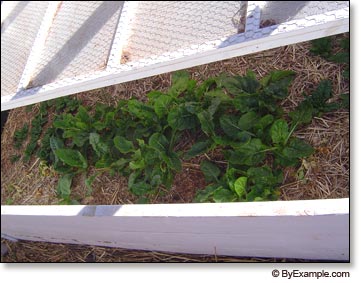
At night we cover each of the single cold frame beds with heavy blankets and canvas tarps. This method does a great job of keeping the plants from freezing.
Future Cold Frames
In the future we will be experimenting with other materials and configurations that might improve our winter growing results.
Planting a Winter Vegetable Garden
For our winter vegetable garden we selected varieties with good frost tolerance. We fully fertilized each of the raised beds with manure before planting our winter vegetable garden.
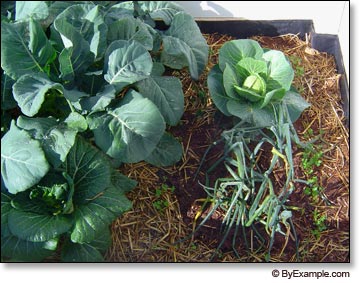 I started plants in July for transplanting in the fall, though this year I may try and find a way to start seedlings even earlier for our winter garden.
I started plants in July for transplanting in the fall, though this year I may try and find a way to start seedlings even earlier for our winter garden.
We enclosed the beds just in the nick of time, only days before the first frost of the season in mid-October. Once the beds were enclosed the plants immediately responded to the new environment. The beds began retaining a lot more moisture and the space within the cold frames became humid. Under the cold frames the plants were also sheltered from the wind and ice. As a result our plants picked up their growth despite the waning winter light.
Gardening in the winter has its challenges, but no more so than desert gardening in the summer. We plan to continue with this experiment until we've achieved a method for producing vegetables year 'round. It is so satisfying to have fresh and tasty homegrown veggies on the cold and darkest days of winter.
Cold Frame Plans
Click here to download our cold frame plans.
Click here to learn more about our raised garden beds.
